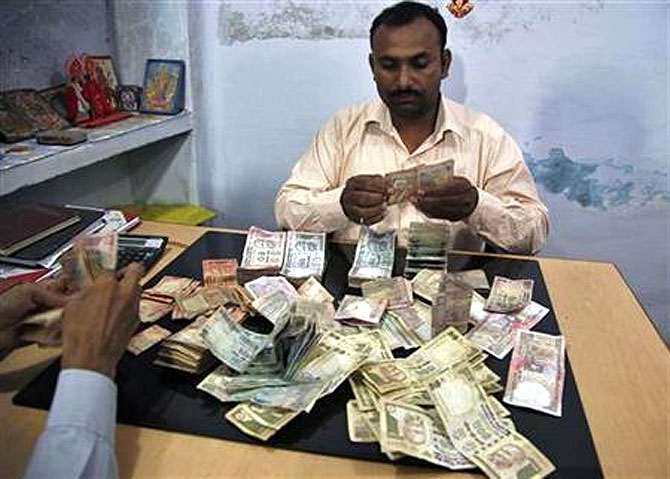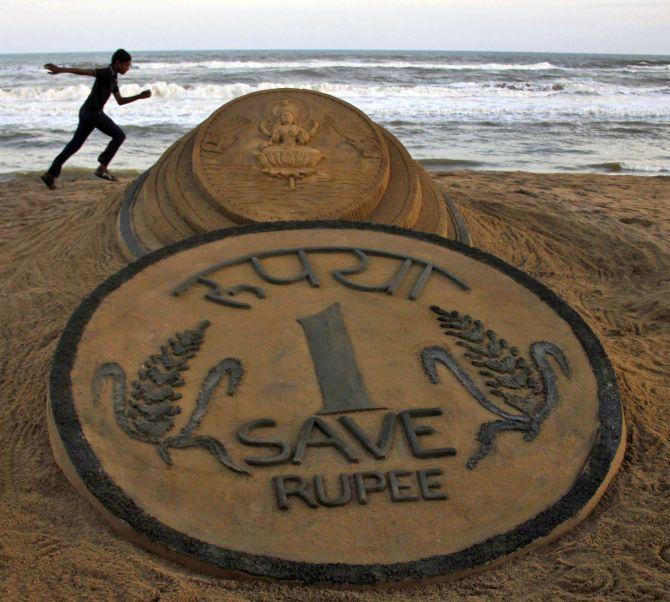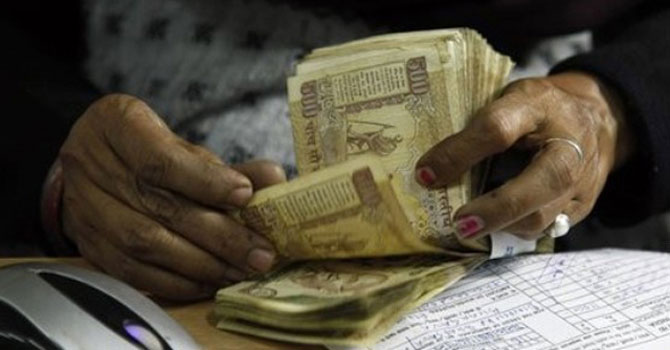Photographs: Daniel Berehulak/Getty Images Nagesh Jadhav
The misgovernance, maladministration, policy paralysis, decision deficit and galaxy of scams have resulted in jobless growth, says Nagesh Jadhav.
Much is debated about the state of the Indian economy during the NDA (1998 – 2004) and UPA regime (2004-2013).
The United Progressive Alliance’s (UPA) growth story is far from truth and is mere a statistical jugglery.
India had a booming economy under Atal Bihari Vajpayee-led NDA. The National Democratic Alliance (NDA) regime efficiently overcame economic sanctions imposed due to Pokhran tests and the Kargil war.
UPA inherited from NDA an economy with growth oriented policies, reforms and environment, which reaped benefits during the first few years of UPA-I.
Yet, the UPA couldn't capitalise much and extend growth throughout their regime owing to their own economic sins.
The misgovernance, maladministration, policy paralysis, decision deficit and galaxy of scams have resulted in jobless growth, declining GDP, increasing current account deficit, rising interest rates, rocketing inflation, mounting external debt and a depreciating rupee, which has resulted in the economic gloom and doom.
…
Why the Indian economy is a sinking ship under UPA
Photographs: Jitendra Prakash/Reuters Nagesh Jadhav
When the NDA left, the GDP figure had touched 8.4 per cent, which showed that the growth oriented policies and reforms initiated by the NDA had started bearing fruits.
It is clearly visible that the GDP remained at an average of 8.5 per cent during UPA-I but by the time UPA-II started winding up, the GDP figures sharply declined from 9.4 per cent in 2010 to 4.5 per cent in 2013, down more than 50 per cent.
This reminds me of the famous Kotak bank ad, which highlights that their 6 per cent deposit rate is not just 2 per cent higher than what other banks offer, but 50 per cent more!).
…
Why the Indian economy is a sinking ship under UPA
Photographs: Reuters
CAD, trade balance and external debt
Current account deficit (CAD) is an important parameter, which illustrates the state of the economy.
Economies with robust current account surplus have export oriented revenues, high savings but weak domestic demand.
On the contrary countries with high current account deficit have larger imports, low saving rates and high personal consumption rates as a percentage of disposable incomes. In 1998, when the NDA took over, the exports started growing and it could achieve current account surplus of nearly 1.5 per cent to GDP.
As the UPA took over, the current account deficit went down again and increased from 0 to -3.7 per cent. Decline in the GDP again reflects the economic mess of the UPA.
Exports exceeding imports is trade surplus as against trade deficit. During the NDA rule the trade deficit was in between 0 to $2 billion from 1998 to 2004, whereas the trade deficit increased to $20 billion in 2013.
When NDA left, the country had a current account surplus of $3.962 billion when the rupee was trading between 40-44 against the USD.
…
Why the Indian economy is a sinking ship under UPA
Photographs: Reuters
The UPA spoiled the current account with a huge deficit of $339 billion during their 9-year regime, which has also resulted in the rupee’s downfall.
There has also been huge increase in the fiscal deficit from -4.3 in 2003-04 to -5.9 in 2012-13.
Another cause of concern is the external debt, which the country owes to its creditors, has shot up significantly from $112 billion in 2004 to $172 billion in 2013 approximately.
This deadly combination of increasing CAD and external debts has put the rupee on the ventilator.
…
Why the Indian economy is a sinking ship under UPA
Photographs: Reuters
Inflation
Inflation is also a measure for the health of the economy. Moderate inflation is considered good for the economy.
UPA’s only achievement, though awful, was doubling the inflation to 9 per cent from NDA’s 5 per cent.
High inflation during the UPA regime attributed to higher oil prices, increased headline inflation and price rise in essential commodities and food items.
The NDA government did a better job in controlling inflation, which led to higher wealth creation than the UPA government since the difference between the GDP growth and the CPI inflation for NDA government was 2 per cent as against the same for UPA government is 0.6 per cent.
…
Why the Indian economy is a sinking ship under UPA
Photographs: Reuters
Industrial production
Industrial production, which attributes to job growth is often termed as an engine of economic growth.
The industrial growth during NDA increased from 4 to 9 per cent from 1998 to 2004, as against the UPA rule it touched to record low of -7.2 per cent in February 2009 after touching 2 per cent in November 2006 and still in the negative with -0.6 per cent in 2013.
This trend is a clear indicator of UPA-I leveraging and benefiting for some time from NDA’s legacy of growth oriented policies, environment and reforms.
…
Why the Indian economy is a sinking ship under UPA
Photographs: Reuters
Agricultural growth
The decline in agriculture contribution to the GDP from 26 per cent in 1998-99 to 13 per cent in 2012-13 is a cause of concern.
There has also been a steep decline in the population dependent on agriculture and allied activities since the UPA regime as against the case in the NDA rule.
Employment
NDA was able to create more jobs in six years than that UPA could do in eight years.
The NDA during 1999-2004, created 60.7 million jobs, on the contrary UPA during 2004-2009, created only 2.7 million jobs.
This is a clear indicator that UPA’s deceiving growth story, did not fuel job growth or create employment but increased the unemployment.
…
Why the Indian economy is a sinking ship under UPA
Photographs: Reuters
Exchange Rate
A strong currency is another indicator of an healthy economy.
The rupee tanked against the dollar from the levels of 40 to 44 in 1998-2004 during the NDA term and from 44 to 64 in 2004-2013 during the UPA also hitting an all-time low of 68.
This has had a spiraling effect to further weaken the economy by resulting in equity market volatility, pulling out of domestic and foreign investors, poor current account deficit, downgrading of Indian stocks, and a high import bill.
The dollar has grown stronger compared to other currencies but the rupee has been among the worst performers.
The Indian economy now is a sinking boat, which sailed well during the NDA regime from 1998-2004.
The above facts have a story to tell that the guidelines, growth and policy reforms laid down by the NDA which had disinvestment of PSUs and FDI in print media to its credit. These efforts turned beneficial during UPA I till corruption and scams broke out during UPA 2, halting growth and reforms.
Overall economic growth is sliding back again to near stagflation.
Though there has been some increase in per capita income, consumer spending and personal savings, they have been marred by rocketing inflation, increasing trade deficit, rising current account deficit, falling industrial production, reduction in contribution of agriculture to GDP and other social indicators like poverty and malnutrition.








article